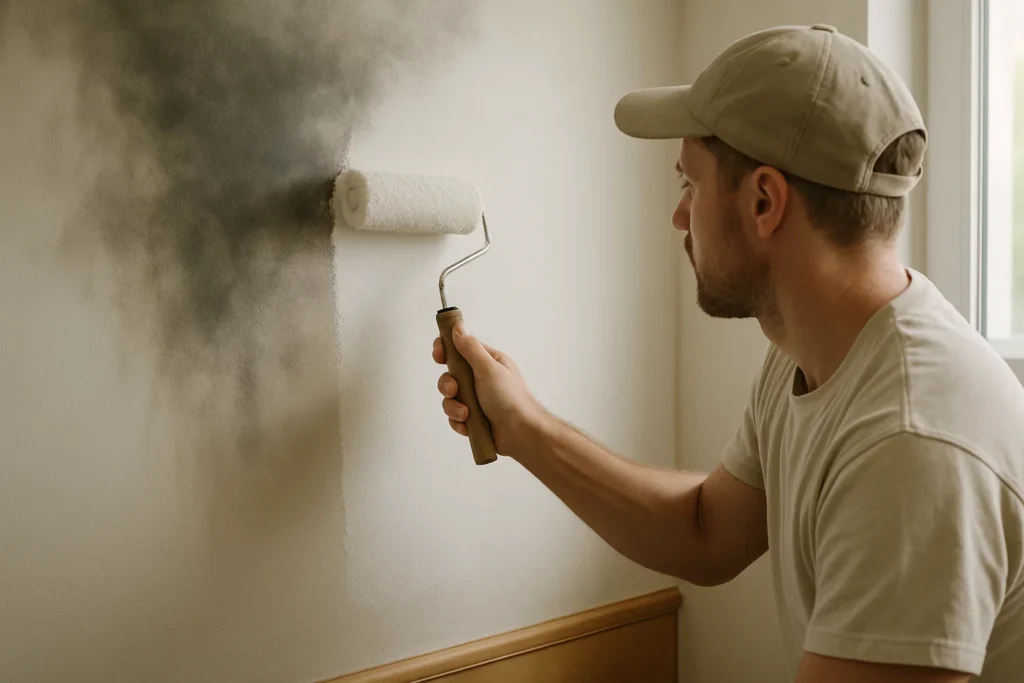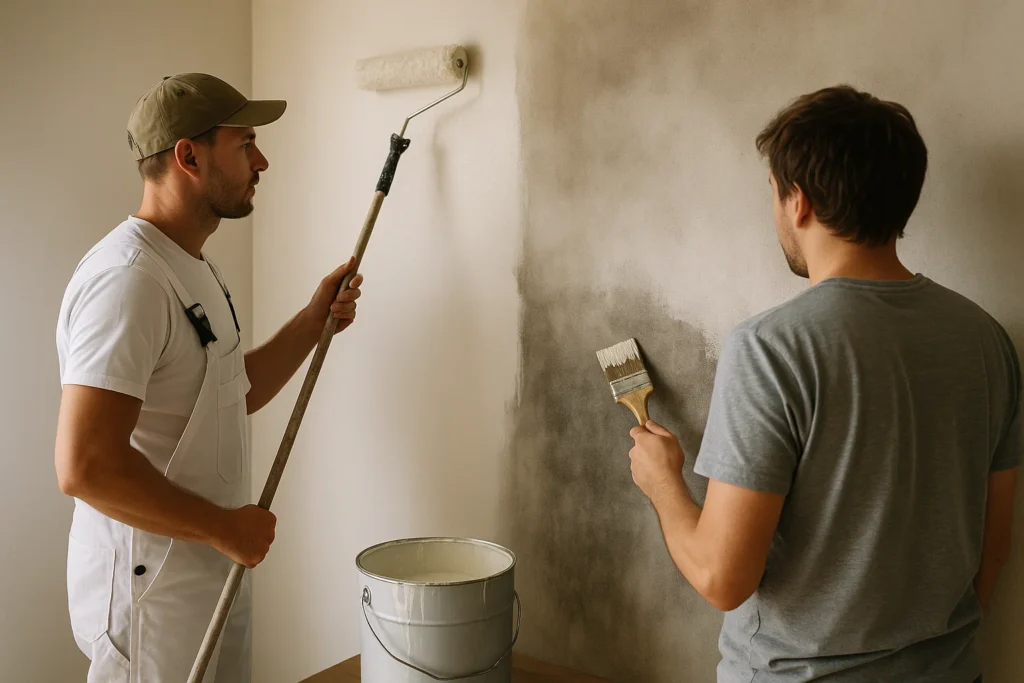Homeowners who are affected by smoke damage from a more serious fire or even a kitchen fire often wonder, how does smoke damage paint? As long as the proper steps have been done, the to fix it.
Attempting to paint over smoke damage without proper preparation often leads to bigger problems. Homeowners may still deal with lingering odors, false smoke or fire alarm triggers, discolored walls, and paint that peels or bubbles unexpectedly. These issues not only affect appearance but also indoor air quality and safety. In this blog, you’ll explore whether smoke damage can be painted over, how to effectively remove layers of white paint from smoke-damaged walls, and when it’s more appropriate to replace drywall entirely.
What Happens When You Paint Over Smoke Damage Without Prep?
Do not be tempted to immediately grab a paintbrush and cover the blackened walls if you wish to restore the feeling of normalcy in your home. There is still work that needs to be done before painting. Ignoring the cleaning and preparatory steps for smoke damage will result in persistent issues that will prove to be troublesome in the future.
Lasting Odors
Smoke damage can lead to accumulating odors that are difficult to eliminate. Even when the surface appears to be clean, smoke residues can still be trapped within drywall, wooden trim, and even cedar beams. If these materials are not properly sealed and the damage is not treated, they emit fumes for years. It is not uncommon to repaint a home, and soon after the home smells fine until humidity increases along with HVAC activity; at which as all strong odors will return.
Mitigating Stains
Mitigating smoke damage’s sooty residue is easier said than done. Due to its oily nature, soot settles on surfaces with a smoky residue. If removed without proper technique and ordinary latex paint is applied over the stains, the surfaces, previously faded, will gradually re-fade over time.
If proper caution is not taken, the same yellow-brown stains will reappear within weeks following the application of fresh paint.
Inadequate Adherence
Soot acts as a barrier between the two layers of paint on freshly painted walls, and also acts as residue that will make the paint not adhere properly. Eventually bubbling, peeling, or flaking can occur.
Health Issues
Walls that have been covered in smoke are likely to contain potentially dangerous residues like carcinogenic toxins from burning plastic and other synthetic materials. If left uncleaned and unsealed, such walls may continue to perpetuate contamination of the indoor air for some time.
Skipping such preparation is not only an aesthetic blunder, it can undermine the health and safety standards of the house.
How to Properly Paint Over Smoke Damage

The good news is smoke damage can be painted over with layers as long as there is a systematic and consistent approach. Below is an outlined guide to efficiently do so:
Clean the Surface Thoroughly
Dry Cleaning the Soot
Prior to applying any cleaning solutions, a considerable amount of loose dry soot needs to be removed. The most effective way to do this is through the use of a chemical sponge, also known as dry cleaning sponge. These sponges are made out of vulcanized rubber and designed to collect dry soot without smudging.
Keep the sponge flat against the wall and wipe using straight, overlapping, gentle strokes. Do not scrub; rather, apply light pressure to lift off the soot. Change the cuts or rotate the sponge’s outer layer to clean it off as you continue to use it.
Wet Cleaning
After the loose soot is removed, wash the walls to get rid of any oily residues. Prepare a cleaning solution of:
- One gallon of water, warm temperature
- One quarter cup of trisodium phosphate (TSP) or heavy-duty degreaser
Put on gloves and eye protection. Use a soft sponge or cloth to scrub the area, rinse with clean water, and pat dry. Make sure to complete the drying step prior to moving onto the next section.
Neutralizing Odor
If the odor persists after cleaning, an odor neutralizing product should be used. Enzyme cleaners and encapsulating smoke odor neutralizers help eliminate the smell-causing compounds.
Always ensure proper ventilation during cleaning and while drying.
Seal with a Smoke-Blocking Primer
This is the most important step. Using a smoke odor and stain blocking primer is crucial. Standard latex primers and paint and primer in one products will not suffice.
Types of Smoke-Blocking Primers:
Shellac-Based Primers: These are considered the best option when dealing with smoke damage since they create a hard barrier that locks both stains and odor within.
Oil-Based Primers: Smoke damage can also be treated with these, although their stronger odor and longer drying times are some of their cons.
Once you’ve chosen the right primer:
- Stir it, but do not shake it.
- Coat the entire surface with a high-quality roller or brush for even application.
- Follow the manufacturer’s guidelines on drying time.
- Apply a second coat if the damage is severe.
Do not rush this step. If the primer is not fully cured, odor will not be effectively contained.
Apply High-Quality Paint
Once the primer has cured completely, select a premium-grade paint:
- Available in various sheens, matte or eggshell finishes are more suitable for interiors as they are easier to maintain as well as conceal surface imperfections. Satin or semi-gloss can be used for easy cleaning.
- Ensure that at least two coats are applied, allowing for each coat to dry fully before applying the next.
Achieving the desired result requires the application of paint to be executed expertly so that a robust finish can be achieved.
When Should You Replace the Drywall Instead?
In certain scenarios, smoke removal and cleaning around fireplaces can be more involved than simply cleaning, priming, and finishing. The following are clear indications where drywall removal is far more preferable than keeping it:
Severe Charring: Drywall that is burned will dramatically reduce the sthe building. Calcinated walls will lead to softening of the walls which will weaken the walls to the point where nothing, not even primer, will restore the structure.
Foul Odors: Active working smells in and around the premises after the job is done points towards an inadequate repair job which, in this case, indicates more restoration work is needed. Quite simply, fumes travel, and the deeper the structure goes behind the drywall, the more difficult it becomes to mask remove the walls.
Water Damage and Mold: Spraying water as a result of fire suppression efforts is common practice. Soft and spongy drywalls which show visible signs of molds are best replaced.
Warped or Crumbling Walls: There is no question rounded drywall which is flaky should be removed as they are not repairable and have undergone significant damage. In case you cannot determine whether replacement is necessary, it is best to consult a smoke damage restoration professional as they would have a more informed assessment.
Professional vs DIY: Which Is Better for Smoke Damage Painting

Evaluate the pros and cons of smoke-damage painting to help you decide whether it would be best to do it yourself or contract a professional.
DIY Benefits:
- Labor costs are not incurred.
- The timeline is set on your preferred schedule.
- It can be rewarding, especially for individuals with a passion for improving their homes.
DIY Drawbacks:
- Demanding physically and takes a long time.
- Crucial steps may be overlooked due to the “out of sight, out of mind” phenomenon.
- Stains or odors that may re-emerged are not covered under warranties.
Professional’s Benefits:
- Completed quicker due to well-trained teams.
- Heavy-duty cleaners and sealers can be accessed.
- Results obtained are guaranteed and comes with warranties.
Professional’s Drawbacks:
- Initial costs are higher, impacting budget more than doing the job solo.
In most cases, light smoke damage from small kitchen fires or limited staining can be managed as long as prep steps are properly executed. On the other hand, if you have extensive soot, strong staining, or persistent odors, a professional recommendation will usually be the most cost-effective solution.
Repair Strategy:How Niemann Painting Handles Smoke Damage in Minnesota Homes
At Niemann Painting, we appreciate the full ramifications of smoke damage. We have effectively and methodically restored numerous homes throughout Minnesota. Here’s the process we use:
Extensive Evaluation: Assessment of all wall surfaces for damage including: stains and soot plus odor which affects how well walls are cleaned.
Detailed Removal: Using a combination of specially formulated odor neutralizers and commercial-grade degreasers as well as soot sponges, our personnel remove any sooty or greasy residues.
Professional Sealing: For shellac based primers with odor and stain shields, the property of breach is nearly impossible. These primers are used for professional sealing.
Expert Painting: We restore your walls to polished pristine condition by applying highly esteemed paints available in a variety of finishes which leaves the walls attractive and smooth.
Final Walkthrough: After we complete restoration, we meet with the family to ensure that they are completely satisfied with the outcome.
By Intact, we mean the attention to detail the team gives to communication, as well as cleaning and the presentation of the area worked on.
Conclusion
In conclusion, it is incredibly essential to carry out the necessary processes to prevent smoke damage from occurring due to improper cleanup and sealing. Following the correct steps must be executed and maintained at all times, otherwise, redoing everything will result in the damage once again. If you suspect that your drywall might be damaged beyond repair or if an unusual smell persists after cleaning, it is advisable to consult a professional.
This situation needs to be managed properly because your health and the air quality in your home depends on it. To reclaim your space contact, Niemann Painting who is eager to help with wall restoration so you can breathe easy once again. We invite you to reach out to us for an evaluation and estimate.
FAQs
No. Smoke damages are a lot more complex than strick applying a latex primer which, would not block the stains and odor of smoke. A shellac-based or oil-based primer meant specifically for smoke damages is needed.
For basic single rooms, the average time to clean, dry, primer, and paint is 2–3 days. More damage or larger areas will increase the time needed to complete the task significantly.
As long as there is proper ventilation and protective equipment, it is possible to remain in the home during paint work. It is safer to ‘temporarily relocate.

